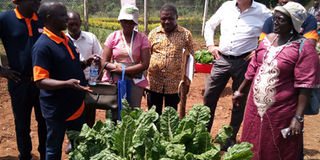Superior vegetable varieties increase yields

An instructor explaining how to make a sack garden during a training in Kampiringisa. Photo by Charlotte Ninsiima.
What you need to know:
- The National Farmers Leadership Centre is promoting the planting of superior vegetable varieties because they are nutritionally superior and yet they provide good concentrations of vitamins, minerals, and insoluble fibre, writes Charlotte Ninsiima
- Test and sterilise the soil by use of sunshine, especially in the hot season. It helps to expose the fungus and bacteria to sunshine. However the best method is cooking the soil with the help of specific pesticides that one can use to sterilise the soil.
More than 120 farmers were trained practically on proper agricultural practices on vegetable production using superior varieties for higher profits at National Farmers Leadership Centre (NFLC), Kampiringisa in Mpigi district.
Rose Namusisi, a field supervisor at NFLC says superior varieties are pest and disease resistant, high yielding and mature fast.
A case in point is the improved variety, Pujita, which takes three months to mature while a local pumpkin can take four months. The former will have 50 fruits and the latter will have 20 fruits.
Patrick Oyee, the chief of party, Integrated Seed Sector Development plus (ISSD), explains that seed sector project focuses on increasing access to quality seed and increase yields. “It focuses on seed value chain on food crops such as beans, cassava and potatoes. Quality declared seed is a new approach for farmer groups to produce quality seed for sale within their community to be able to avail themselves with that particular of seed.”
Prepare the seedlings
First of all, seedlings are planted in sterilised soil or cock peat in trays under black netted shelters. This aims to keep the whole root system intact without any damage before they are transplanted to the garden. This is referred to as an improved nursery bed system.
Backyard farming
Adopt backyard farming to maximise space left outside house.
Vegetables that include carrots, beetroot, pumpkin, Sukuma, lettuce and others can be planted in a sack garden, food tower, in empty cans or old tyres.
The tinned plants are hanged in a row under a table like structure. Other vegetables are creatively planted in a circular form to beautify the home. The vegetables are a source of food for nutritional value, and a source of income.
Apply a natural fertiliser
Leafy vegetables need more of nitrogen while others such as tomatoes need calcium chloride for fruiting. When the leaves are green, one identifies presence of nitrogen while yellow signifies deficiency.
Namusisi emphasises that chicken droppings are the best manure due to the low water intake. The droppings are richer in nutrients compared to cow dung.
Also chicken droppings help to raise the soil potential of hydrogen. It affects the uptake of other nutrients for example when PH is low, it affects the uptake of phosphorous.
However, if one cannot access chicken droppings, fertilisers especially Diammonium Phosphate (DAP), is applied at transplanting. After two weeks, calcium ammonia nitrate (CAN) rich in nitrogen and calcium, is recommended for the firmness of the plant. Plants lacking calcium are very soft and pests can easily destroy them.
When to spray
“When a plant has wilted or has dried up, first identify if it’s infected with a bacteria or fungal wilt. To simply differentiate them, uproot and cut the base of the stem and deep it in water. When one witness bubbles come out, that signals a fungal wilt while if there are no bubbles that is a bacteria wilt. Wilt is soil borne, therefore one needs to uproot the affected plant and destroy it to prevent further spread as the control measure,” She adds
Musau says it is vital for one to know what they are controlling or spraying against.
“Make correct choices of the pesticide. Read the label well to apply the right dosages. In addition, apply in the right weather condition.”
Test the soil
Test and sterilise the soil by use of sunshine, especially in the hot season. It helps to expose the fungus and bacteria to sunshine. However the best method is cooking the soil with the help of specific pesticides that one can use to sterilise the soil.
Emmanuel Musau, an agricultural officer, says, for some who can afford methyl bromide. Methyl bromide is most often used as a gas fumigant against insects, termites, rodents, weeds, nematodes, and soil-borne diseases.




